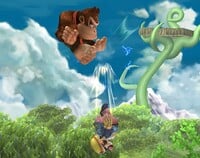Meteor smash


A meteor smash is a type of attack in the Super Smash Bros. series that strikes opponents downwards, as opposed to horizontally or upwards like most attacks. Meteor Smashes are primarily designed to KO or gimp recovering opponents at especially low damage. As such, with their potential potency to take a stock especially early, most conventional meteor smashes are somewhat slow to execute or require sweetspotting, requiring accurate timing and positioning to land a successful blow.
Some meteor smashes are not meant for edge-guarding and are done only to knock opponents into other hits of the attack. Other meteor smashes can damage only opponents that are on the ground, making them impossible to send targets downwards. These are known as unconventional meteor smashes.
In Super Smash Bros. 4, characters that are meteor smashed onto a floor will bounce back up. While this allows certain Final Smashes to incorporate downwards finishers and still result in KOs when used onstage, it allows players to tech even if they were standing on the ground. In addition, stronger meteor smashes are now denoted by a unique sound effect upon connection.
General characteristics
As they hit opponents downwards, meteor smashes cause targets that are not in the air to immediately bounce off the ground they're standing on, reducing the knockback received by 20% and thus making such attacks much weaker and less reliable KO moves on grounded targets; if the intended knockback is below a certain amount it will not even deliver any vertical knockback at all, and instead merely cause flinching and perhaps tripping. As a result, only the strongest meteor smashes (such as Ganondorf's down aerial) are viable KO moves in on-stage situations. In Super Smash Bros. 4, even if the victim is in midair, they will now bounce off the ground regardless if they have sustained a notable amount of damage for the proper amount of knock-back power.
Despite their reduced power on grounded opponents, the amount of hitstun delivered by a meteor smash is not affected by the knockback reduction, meaning such moves will cause more hitstun than non-meteor smashes with equal knockback. Combined with their vertical trajectory, this results in meteor smashes being excellent combo starters on grounded opponents.
Meteor cancelling
Meteor cancelling is the act of instantly negating the downwards knockback of a meteor smash by jumping or using an up special after being hit. In Melee, a meteor cancel can be done 8 frames after the hitlag ends, producing a distinctive wind-cutting sound and a sparkle (the character will also briefly glow white); in Brawl, meteor cancels are unindicated and can only be done after 25 frames (depending on the character, see below), and attempting to jump to meteor cancel before this will result in a 40 frame penalty before the window opens (this penalty does not apply if attempting to use an up special to meteor cancel without making a jump input). Characters can meteor cancel even if they were hit while grounded, though they must have bounced off a ceiling and still be taking the now-downwards knockback to do so.
Meteor cancelling does not exist in Smash 64, and thus meteor smashes in that game are functionally equivalent to spikes.
Characters with unusual meteor cancel windows in Brawl
In Brawl, some characters can meteor cancel sooner than others. Most characters can meteor cancel after 25 frames, while others have different values:
- Charizard: 30 frames
- Ivysaur: 15 frames
- Meta Knight: 32 frames
- Olimar: 15 frames
- Pit: 30 frames
- Wolf: 60 frames
- Yoshi: 20 frames
- Zero Suit Samus: 15 frames
It is curious how characters that use wings for multiple jumps have a longer-than-usual window whereas those who inflate for multiple jumps do not, while characters who rely on tether recoveries have a shorter window to accommodate for their recovery weakness. Wolf's 60-frame delay in meteor cancelling remains inexplicable, though.
Similar techniques
A meteor smash is not to be confused with a spike; while spikes also have downwards knockback angles, they are diagonal enough to not be recognized by the game as a meteor smash, and thus cannot be meteor cancelled. Despite this, many smashers use the term "spike" to refer to meteor smashes, with the term "true spike" referring to spikes. Meteor smashes are also not to be confused with a stage spike, where attacks with standard knockback angles can cause opponents to bounce off the underside of a stage and fly downwards, unable to meteor cancel.
Lists of meteor smashes
Not all characters have access to a meteor smash (e.g. Pikachu in the first three games). The characters that can meteor smash and their respective meteor smashes are listed and described here. Some items, such as Moltres and the streams of a Super Scope, as well as the attacks of some bosses, also have meteor smash hitboxes, but they are not listed here. Spikes and semi-spikes, due to their differing properties, are not listed here. This list does not include unconventional meteor smashes.
- List of meteor smashes (SSB)
- List of meteor smashes (SSBM)
- List of meteor smashes (SSBB)
- List of meteor smashes (SSB4)
See also
- Spike – an attack that sends the opponent downwards yet cannot be canceled.
- Semi-spike – an attack that hits the opponent at a very low horizontal angle, minimizing recovery opportunities.
- Footstool jump – a technique in Super Smash Bros. Brawl and Super Smash Bros. 4 which makes a character jump on their opponent's head. If done on an aerial opponent, it causes them to fall downward.


